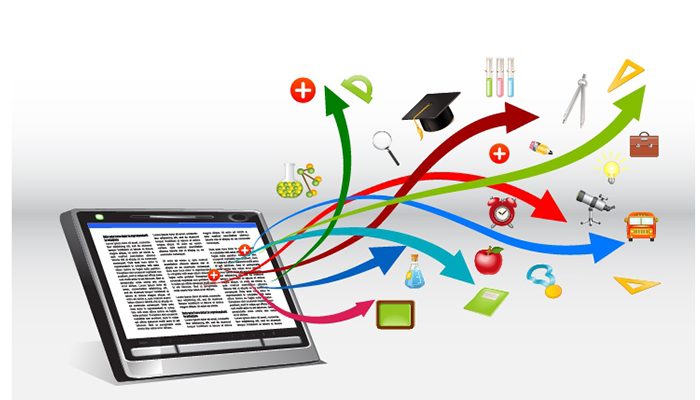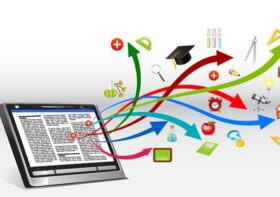Digital Content in Culturally Responsive Teaching (CRT) and Personalized Learning (PL): What Should Educators Do?

Digital content refers to the online curriculum and instructional materials based on core subjects and electives used by students in an online or blended learning environment (EdTechReview, 2013). Educators can use digital content to integrate pedagogical frameworks, such as culturally responsive teaching and personalized learning, into classroom instruction. To this extent, educational technology coaches can partner with educators to identify digital learning content that is culturally relevant, developmentally appropriate, and aligned to content standards. This goal aligns with the ISTE Coaching Standard 3 (Collaborator), especially point 3b. In the following elaboration, we will see how digital content is articulated in the learning process to make students feel valued, honored, and empowered perceived by CRT and PL frameworks.
The Role of Digital Content in CRT and PL
Great teachers leave the most significant lasting impact on their students. They often see students for who they are before they see this themselves. These teachers uplift their students by developing their interests, celebrating their uniqueness, and challenging their assumptions about the world and themselves. One way to achieve this goal is to prioritize diversity, equity, and inclusion when personalizing learning. Also, culturally responsive education, transformative justice practices, and anti-racism are other critical components of this work (Broussard et al., 2016).
While personalized learning is never solely about the technology or digital content, integrating flexible content and tools is essential in creating a successful personalized learning classroom. By leveraging digital content and tools, teachers can provide students with individualized paths and pace. Teachers also understand how to use foundational, adaptive, and highly customizable content and tools to differentiate the path, pace, and performance tasks of learning. Where digital content and tools are used, they do not replace the teacher; instead, they work alongside the teacher to better support students’ needs by providing remediation, practice, extension, and various ways to demonstrate knowledge authentically (Johns, 2018). In other words, in personalized learning, educators purposefully use digital content and tools.
Moreover, learning design needs to be flexible, and technologies can be created to support representation, adaption, sharing, and implementation through broad-ranging colocation practices. It opens the door to engage in culturally relevant teaching methods that empower learners and has the potential to push students to have critical perspectives on policies and practices that have a direct impact on their lives and communities (Ladson-Billings 2014, cited in Engerman & Otto, 2021).
On the other hand, digital content can serve as an equalizer in culturally responsive teaching in schools (Beerer, 2017). To this extent, educators must remember that not every student needs a device in a classroom powered by digital content. Therefore, educators need to check what all students need and deserve in “going digital” cultural responsiveness through the following questions:
- Is instruction relevant to students’ lives and the world around them?
- Is your teaching preparing students to be future-ready?
- Do the instructional resources enhance students’ learning?
- Do the instructional resources reflect the students in any way?
- How will you impact or change students’ lives?
What Should Educators Do?
This part elaborates on how educators can use digital content to implement culturally responsive teaching effectively. Therefore, Beerer (2017) lists the following ways:
- Integrate digital content into your instruction. Digital content captures up-to-date images, situations, and subjects to illustrate and pose real-world problems. This practice will increase engagement among students of all abilities and backgrounds and allow them to “see themselves” in the content, thus making classroom instruction even more relevant.
- Ensure the digital content is high-quality. High-Quality Digital Content (HQDC) provides learners multiple pathways to understanding, ensuring that there is almost always another pathway to learning immediately available. To this point, we can begin with a graphically attractive visual design, and then students are naturally drawn to the material.
- To motivate students, use digital activities such as high-quality graphics, games, virtual labs, and robust math and science challenges. Think of digital content as the thin end of the wedge and use it to engage students in topics traditionally taught through direct instruction. This strategy will not only create more student-centered instructional opportunities and encourage students to think more deeply, but it will also help support teachers as they become facilitators of learning.
- Build students’ vocabularies with various digital resources such as videos, animations, and images. Different types of videos, images, animations, and definitions (of course) enable students to determine the meaning of content vocabulary while exerting control over how they best learn words. This strategy will help in bringing elements of learner agency into your classroom.
- Engage students in experiences, such as a virtual field trip to the North Pole, that they would not ordinarily have, or perhaps may never have, to build an understanding of others. Recent technological advancements in virtual reality and augmented reality can help build new experiences for students that would be impossible to replicate in any other way. These experiences work with minimal technology investment and can be viewed with the inexpensive Google Cardboard device. In addition, students can access these experiences on a laptop, PC, or tablet and still receive a unique 360° perspective through arrow keys, a mouse, or by dragging on a touch screen.
- Close the “belief gap.” The belief gap is a lack of belief among some educators in the potential of students from low-income families and students of color. Going digital allows us to move students from consumers of information to creators of information and empowers them to share, display, and showcase their work, thinking, and accomplishments to the community and globally. Equally important is that by encouraging students to use digital resources in their daily school work, educators can show students that they are preparing them for success in the world beyond the classroom.
- Know your students and the communities you serve. Take the time to learn about your students’ culture, history, and backgrounds. Just as digital content can fill in the gaps in your student’s understanding of the world, you can use it for personal and professional development to learn about who your students are and where they come from. In addition, take the time to know your students’ circumstances. For example, find out which students do not have internet connections at home so you can devise strategies to help them access content outside the classroom. Alternatively, learn which language is spoken in your students’ homes to create plans to better connect with parents for whom English is not the primary language. This type of information will help you better serve your students.
Besides, leveraging digital technologies to create a culturally-responsive classroom is essential. This way, educators can consider the following strategies (TeacherPediaNG, 2021):
1. Learn about your students
To meet the needs of your students, we have to know who they are. Adopting open communication to learn about your students is a good teaching style to help your students feel valued. Open communication also helps to reveal their learning needs and preferences. We can use Zoom, Google Meet, or other video conferencing apps to communicate with students. Also, we can use Google Forms to create and distribute questionnaires or surveys and gather information about your students. These strategies also work for personalized learning environments.
2. Celebrate Diversity
As educators, we can also consider publishing content in multiple languages not just for inclusion but to help students gain proficiency in other languages for effective communication. On the other hand, apps like Google Translate, Reverso, and iTranslate help you communicate with people that do not speak English. You can also integrate these tools into the school’s website. Besides, EdTech tools, such as YouTube Live or YouNow, will help you virtually bring parents, friends, and well-wishers from different regions for special events or showcasing learning activities within the school.
3. Promote collaboration
Promoting collaboration is the easiest way to encourage peer learning and groom students that are not discriminatory due to cultural differences. Google Hangouts, ePals, Skype, and even Empatico allow real-time and asynchronous collaboration and support among teachers and students worldwide. Besides, teaching with online resources can be used for building a multicultural classroom, such as Google Cultural Institute.
4. Create a classroom library
Creating a comprehensive classroom library helps teachers to develop a culturally-responsive classroom. It could be an e-library or physical library with books, research works, and stories detailing the history and culture of different regions across the globe. Google search features also allow students to find resources peculiar to other cultures, narrowing searches by language or region/country.
One additional point in using digital content in CRT and PL, educators are encouraged to use evaluation instruments designed for the digital learning resources. Some studies elaborate on the importance of designing evaluation instruments for three reasons (Mhouti et al., 2013). First, the design of multimedia learning materials is frequently not informed by relevant research in psychology and education (Nesbit, Li, & Leacock, 2006; Shavinina & Loarer, 1999). This design has resulted in easy access to various digital learning resources. Second, to mitigate this search problem, some resource repositories use quality metrics to order search results (Vargo, Nesbit, Belfer, & Archambault, 2003). The efficacy of this technique is directly dependent on the validity of the evaluation tool used to generate the quality ratings. Third, quality criteria for summative evaluations can potentially drive improvements in design practice (Nesbit, Belfer, & Vargo, 2002). Mhouti et al. (2013) emphasize that awareness of these criteria, which can affect resource quality, is an essential step toward elaboration.
To sum up, educators need ample time to define, research, explore, and select digital content to implement in a face-to-face, distance, or hybrid classroom. This way, coaching support can facilitate educators to become proficient through regular practice. Also, educators are encouraged to collaborate with their colleagues by sharing what they have learned from reflecting on, researching, and responding to online resources. Learning from students’ successes and families’ feedback to know what material best suits their learning needs can improve the practice (Devonish-mazzotta, 2020).
References
Beerer, K. (2017). Building Culturally Responsive Classrooms with Digital Content. Getting Smart.Com. https://www.gettingsmart.com/2017/02/culturally-responsive-classrooms-digital-content/
Broussard, J., Cmap, K., Dougherty, N., Flanders, C., Schantz, D., & Strunk, C. (2016). The Core Four of Personalized Learning. https://www.edelements.com/lp-the-core-four-of-personalizing-learning-white-paper?hsCtaTracking=376c6bf1-d0ee-41ec-934e-9d01e5d0437a%7Cf73f76bc-7aeb-4c9b-8c33-37ac4a598c07
Devonish-mazzotta, K. (2020). Supporting Learners with Culturally Relevant Digital Resources. Winter 2020 Issue. https://etfovoice.ca/feature/supporting-learners-culturally-relevant-digital-resources
EdTechReview. (2013). Selecting Digital Content For Your Educational Institution. https://edtechreview.in/e-learning/338-how-to-select-digital-content
Engerman, J. A., & Otto, R. F. (2021). The shift to digital: designing for learning from a culturally relevant interactive media perspective. Educational Technology Research and Development, 69(1), 301–305. https://doi.org/10.1007/s11423-020-09889-9
ISTE. (2022). ISTE Standards: Coaches. https://www.iste.org/standards/iste-standards-for-coaches
Johns, S. (2018). The Core 4 Elements of Personalized Learning. Education Elements. https://www.edelements.com/blog/The-core-4-of-personalized-learning
Mhouti, A. El, Nasseh, A., & Erradi, M. (2013). How to evaluate the quality of digital learning resources ? International Journal of Computer Science Research and Application, 03(03), 27–36. https://www.researchgate.net/publication/260392089_How_to_evaluate_the_quality_of_digital_learning_resources
TeacherPediaNG. (2021). What is a Culturally-responsive How to Use Technology to Create a Culturally-responsive classroom? https://teacherpedia.net/2021/12/13/using-technology-to-create-a-culturally-responsive-classroom/


Melissa Dunworth
Hi Ignasia, thank you for such a thoughtful post. I truly loved this quote “Great teachers leave the most significant lasting impact on their students. They often see students for who they are before they see this themselves.” It really reminds me of the power and importance of the role of the teacher, and making sure that we are being culturally responsive in our teaching can only help our students continue to grow.
Chelly Rody
Thank you for your post, Ignas! I appreciate how you have woven digital content into culturally-responsive teaching as well as personalized learning. I especially like the section about our role as educators in using digital content to promote culturally responsive teaching.